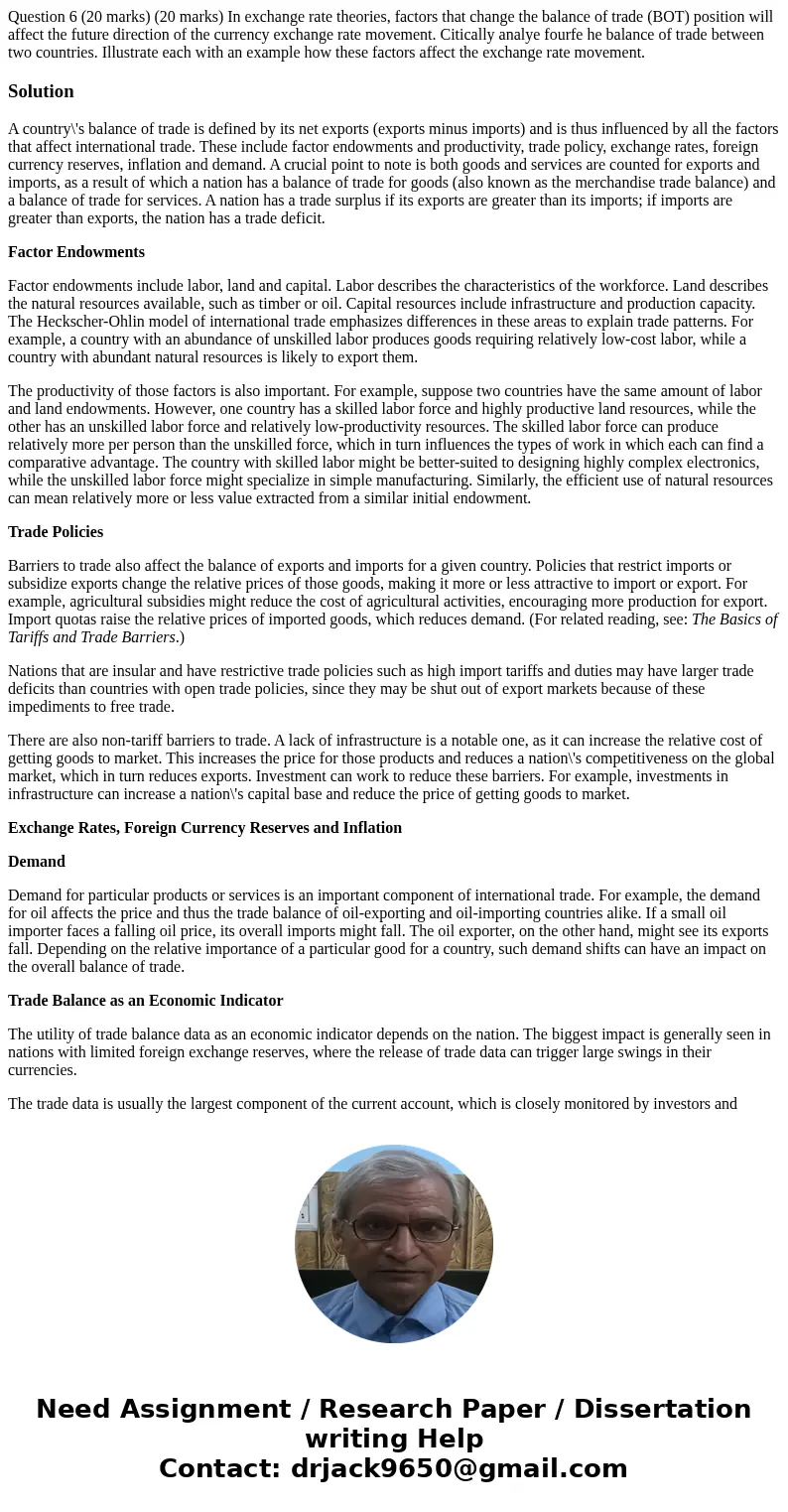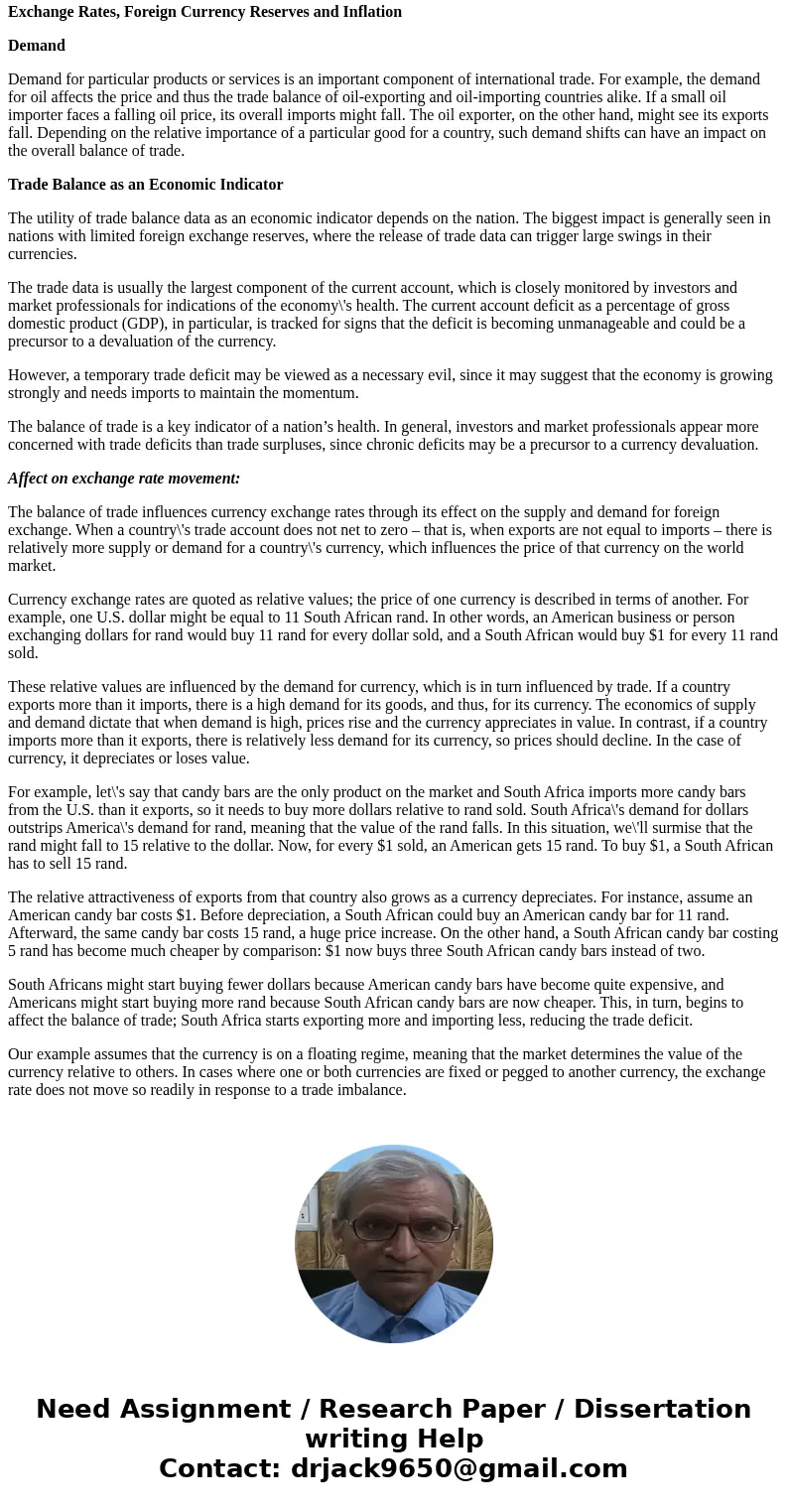Question 6 20 marks 20 marks In exchange rate theories facto
Solution
A country\'s balance of trade is defined by its net exports (exports minus imports) and is thus influenced by all the factors that affect international trade. These include factor endowments and productivity, trade policy, exchange rates, foreign currency reserves, inflation and demand. A crucial point to note is both goods and services are counted for exports and imports, as a result of which a nation has a balance of trade for goods (also known as the merchandise trade balance) and a balance of trade for services. A nation has a trade surplus if its exports are greater than its imports; if imports are greater than exports, the nation has a trade deficit.
Factor Endowments
Factor endowments include labor, land and capital. Labor describes the characteristics of the workforce. Land describes the natural resources available, such as timber or oil. Capital resources include infrastructure and production capacity. The Heckscher-Ohlin model of international trade emphasizes differences in these areas to explain trade patterns. For example, a country with an abundance of unskilled labor produces goods requiring relatively low-cost labor, while a country with abundant natural resources is likely to export them.
The productivity of those factors is also important. For example, suppose two countries have the same amount of labor and land endowments. However, one country has a skilled labor force and highly productive land resources, while the other has an unskilled labor force and relatively low-productivity resources. The skilled labor force can produce relatively more per person than the unskilled force, which in turn influences the types of work in which each can find a comparative advantage. The country with skilled labor might be better-suited to designing highly complex electronics, while the unskilled labor force might specialize in simple manufacturing. Similarly, the efficient use of natural resources can mean relatively more or less value extracted from a similar initial endowment.
Trade Policies
Barriers to trade also affect the balance of exports and imports for a given country. Policies that restrict imports or subsidize exports change the relative prices of those goods, making it more or less attractive to import or export. For example, agricultural subsidies might reduce the cost of agricultural activities, encouraging more production for export. Import quotas raise the relative prices of imported goods, which reduces demand. (For related reading, see: The Basics of Tariffs and Trade Barriers.)
Nations that are insular and have restrictive trade policies such as high import tariffs and duties may have larger trade deficits than countries with open trade policies, since they may be shut out of export markets because of these impediments to free trade.
There are also non-tariff barriers to trade. A lack of infrastructure is a notable one, as it can increase the relative cost of getting goods to market. This increases the price for those products and reduces a nation\'s competitiveness on the global market, which in turn reduces exports. Investment can work to reduce these barriers. For example, investments in infrastructure can increase a nation\'s capital base and reduce the price of getting goods to market.
Exchange Rates, Foreign Currency Reserves and Inflation
Demand
Demand for particular products or services is an important component of international trade. For example, the demand for oil affects the price and thus the trade balance of oil-exporting and oil-importing countries alike. If a small oil importer faces a falling oil price, its overall imports might fall. The oil exporter, on the other hand, might see its exports fall. Depending on the relative importance of a particular good for a country, such demand shifts can have an impact on the overall balance of trade.
Trade Balance as an Economic Indicator
The utility of trade balance data as an economic indicator depends on the nation. The biggest impact is generally seen in nations with limited foreign exchange reserves, where the release of trade data can trigger large swings in their currencies.
The trade data is usually the largest component of the current account, which is closely monitored by investors and market professionals for indications of the economy\'s health. The current account deficit as a percentage of gross domestic product (GDP), in particular, is tracked for signs that the deficit is becoming unmanageable and could be a precursor to a devaluation of the currency.
However, a temporary trade deficit may be viewed as a necessary evil, since it may suggest that the economy is growing strongly and needs imports to maintain the momentum.
The balance of trade is a key indicator of a nation’s health. In general, investors and market professionals appear more concerned with trade deficits than trade surpluses, since chronic deficits may be a precursor to a currency devaluation.
Affect on exchange rate movement:
The balance of trade influences currency exchange rates through its effect on the supply and demand for foreign exchange. When a country\'s trade account does not net to zero – that is, when exports are not equal to imports – there is relatively more supply or demand for a country\'s currency, which influences the price of that currency on the world market.
Currency exchange rates are quoted as relative values; the price of one currency is described in terms of another. For example, one U.S. dollar might be equal to 11 South African rand. In other words, an American business or person exchanging dollars for rand would buy 11 rand for every dollar sold, and a South African would buy $1 for every 11 rand sold.
These relative values are influenced by the demand for currency, which is in turn influenced by trade. If a country exports more than it imports, there is a high demand for its goods, and thus, for its currency. The economics of supply and demand dictate that when demand is high, prices rise and the currency appreciates in value. In contrast, if a country imports more than it exports, there is relatively less demand for its currency, so prices should decline. In the case of currency, it depreciates or loses value.
For example, let\'s say that candy bars are the only product on the market and South Africa imports more candy bars from the U.S. than it exports, so it needs to buy more dollars relative to rand sold. South Africa\'s demand for dollars outstrips America\'s demand for rand, meaning that the value of the rand falls. In this situation, we\'ll surmise that the rand might fall to 15 relative to the dollar. Now, for every $1 sold, an American gets 15 rand. To buy $1, a South African has to sell 15 rand.
The relative attractiveness of exports from that country also grows as a currency depreciates. For instance, assume an American candy bar costs $1. Before depreciation, a South African could buy an American candy bar for 11 rand. Afterward, the same candy bar costs 15 rand, a huge price increase. On the other hand, a South African candy bar costing 5 rand has become much cheaper by comparison: $1 now buys three South African candy bars instead of two.
South Africans might start buying fewer dollars because American candy bars have become quite expensive, and Americans might start buying more rand because South African candy bars are now cheaper. This, in turn, begins to affect the balance of trade; South Africa starts exporting more and importing less, reducing the trade deficit.
Our example assumes that the currency is on a floating regime, meaning that the market determines the value of the currency relative to others. In cases where one or both currencies are fixed or pegged to another currency, the exchange rate does not move so readily in response to a trade imbalance.


 Homework Sourse
Homework Sourse